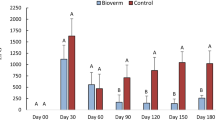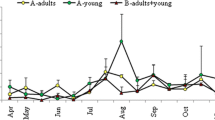Abstract
Biological control is an alternative method to reduce the population of parasites through natural predators. A promising option of biological control in the reduction of infective larvae on pasture is the use of nematophagous fungi. In this study, the efficacy of the nematophagous fungus Duddingtonia flagrans in controlling gastrointestinal nematode parasites in field-raised horses was tested. Ten foals with an average age of 12 months were divided in two groups: five males constituted the treated group and five females constituted the control group. Each group was introduced in a field of mixed pasture with approximately 5 ha. The treated group received the fungus D. flagrans at a concentration of 106 chlamydospores per kilogramme of animal body weight daily, mixed with horse food for 5 months. The control group did not receive the fungus. Samples were collected to perform eggs per gramme (EPG) counts weekly. Coproculture and collection of pasture were done monthly for larvae counting. No significant difference was observed in the EPG counting and in the number of larvae recovered from coprocultures, where cyathostomines, Strongylus and Trichostrongylus spp. were found after monthly larvae counting. No significant difference was observed in the EPG counts, and Trichostrongylus sp. was identified. The number of recovered larvae on pasture was significantly lower in the treated group in the last month of treatment, showing a reduction of 73.5% (p < 0.05). As such, the fungus was able to reduce the number of infective larvae in the pasture. Nevertheless, this did not reflect in a decrease of parasitic infection during the 5-month study period.




Similar content being viewed by others
References
Almeida GL, Marin JB, Gomes RO, Jardim Filho JO, Molento MB (2004) Frequência de tratamento antiparasitário e falta de eficácia em helmintos de equinos PSC no Jockey Club de Santa Maria. RS Rev Bras Parasit Vet 13:128
Amarante AFT, Padovani CR, Barbosa MA (1996) Contaminação de larvas de nematóides gastrintestinais parasitos de bovinos e ovinos em Botucatu-SP. Rev Bras Parasit Vet 5:65–73
Araujo JM, Araujo JV, Braga FR, Carvalho RO (2010) In vitro predatory activity of nematophagous fungi after passing through gastrointestinal tract of equine on infective larvae of Strongyloides westeri. Parasitol Res 107:103–108
Baudena MA, Chapman MR, Larsen M, Klei TR (2000) Efficacy of the nematophagous fungus Duddingtonia flagrans in reducing equine cyathostome larvae on pasture in south Louisiana. Vet Parasitol 89:219–230
Bird J, Herd RP (1995) In vitro assessment of two species of nematophagous fungi (Arthrobotrys oligospora and Arthrobotrys flagrans) to control the development of infective cyathostome larvae from naturally infected horses. Vet Parasitol 56:181–187
Bonneau S, Maynard L, Tomczuk K, Kok D, Eun HM (2009) Anthelmintic efficacies of a tablet formula of ivermectin praziquantel on horses experimentally infected with three Strongylus species. Parasitol Res 105:817–823
Braga FR, Araujo JV, Silva AR, Araujo JM, Carvalho RO, Tavela AO, Campos AK, Carvalho GR (2009) Biological control of horse cyathostomin (Nematoda: Cyathostominae) using the nematophagous fungus Duddingtonia flagrans in tropical southeastern Brazil. Vet Parasitol 164:335–340
Courtney CH (1999) Seasonal transmission of equine cyathostomin in warm climates. Vet Parasitol 85:173–180
Cullinane AA, Barr B, Duncan JL, Mulcahy G, Smith, IM, Timoney JF (2006) Infections diseases In: Higgins AJ, Snyder, JR (ed) The Equine Manual, Elsevier, 2nd edn. Edinburgh, pp 1–111
Dias AS, Araujo JV, Campos AK, Braga FR, Fonseca TA (2007) Application of a formulation of the nematophagous fungus Duddingtonia flagrans in the control of cattle gastrointestinal nematodiosis. World J Microbiol Biotechnol 23:1245–1252
Eisker M, Mirck MH (1986) The distribution of inhibited early third stage Cyathostominae larvae in the large intestine of the horse. Parasitol Res 75:815–820
Fernandez AS, Larsen M, Henningsen E, Nansen P, Grønvold J, Bjørn H, Wolstrup J (1997) Effect of the nematode-trapping fungus Duddingtonia flagrans on the free-living stages of horse parasitic nematodes: a plot study. Vet Parasitol 73:257–266
Fernandez ASE, Henningsen M, Larsen P, Nansen J, Grønvold J, Sondergaard J (1999) A new isolate of the nematophagous fungus Duddingtonia flagrans a biological control agent against free-living larvae of horse strongyles. Equine Vet J 31:488–491
Gordon HL, Whitlock HV (1939) A new technique for counting nematode eggs in sheep faeces. J Council Sci Ind Res 12:50–52
Jobim MB, Santurio JM, de la Rue M (2008) Duddingtonia flagrans: controle biológico de nematódeos de bovinos a campo. Ciência Rural 38:2256–2263
Kahn LP, Norman TM, Walkdeb-Brown SW, Crampton A, O'Connor LJ (2007) Trapping efficacy of Duddingtonia flagrans against Haemonchus contortus at temperatures existing at lambing in Australia. Vet Parasitol 146:83–89
Larsen M (1999) Biological control of helminths. Int J Parasitol 29:139–146
Larsen MM, Nansen P, Grøndahl C, Thamsborg SM, Grønvold J, Wolstrup J, Henriksen SA, Monrad J (1996) The capacity of the fungus Duddingtonia flagrans to prevent strongyle infections in foals on pasture. Parasitology 113:1–6
Martins IVF, Correia TR, Souza CP, Fernandes JL, Santanna FB, Scott FB (2001) Frequência e distribuição de larvas de ciatostomíneos (Strongylidae: Cyathostominae) encistadas nas mucosas intestinais de equinos oriundos de apreensão, no estado do Rio de Janeiro. Rev Bras Parasit Vet 10:45–47
MAFF (Ministry Of Agriculture, Fisheries and Food) (1977) Manual of veterinary parasitological laboratory technique: Technical Bulletin, n. 18. London: Her Majesty's Stationery Office
Mfitilodze MW, Hutchinson GW (1990) Prevalence and abundance of equine strongyles (Nematoda: Strongyloidea) in Tropical Australia. J Parasitol 76:487–494
Molento MB (2001) Técnica de contagem de larvas no pasto como ferramenta para diagnóstico parasitológico. In: 2º Simpósio da Rede de Helmintologia para América Latina e Caribe. Anais. Buenos Aires, Argentina, CD-ROM.
Mota MA, Campos AK, Araújo JV (2003) Controle biológico de helmintos parasitos de animais: estágio atual e perspectivas futuras. Pesq Vet Bras 23:93–100
Paraud C, Pors I, Chartier C (2007) Efficiency of feeding Duddingtonia flagrans chlamydospores to control nematode parasites of first-season grazing goats in France. Vet Res Comm 31:305–315
Roberts FHS, O'Sullivan JP (1950) Methods for egg counts and larval cultures for strongyles infesting the gastro-intestinal tract of cattle. Australian Agricultural Research, v.1
Santos CP, Charles TP, Rodrigues MLA (2001) Predatory activity of Arthrobotrys oligospora and Duddingtonia flagrans on pre-parasitic larval stages of cyathostominae under different constant temperatures. Ciência Rural 31:839–842
Silva AR, Araújo JV, Braga FR, Frassy LN, Tavela AO, Carvalho RO, Castejon FV (2009) Biological control of sheep gastrointestinal nematodiasis in a tropical region of the southeast of Brazil with the nematode predatory fungi Duddingtonia flagrans and Monacrosporium thaumasium. Parasitol Res 105:1707–1713
Stear MJ, Doligalska M, Donskow-Schmelter K (2007) Alternatives to anthelmintics for the control of nematodes in livestock. Parasitology 134:139–151
Stromberg BE (1997) Environmental factors influencing transmission. Vet Parasitol 72:247–264
Terril TH, Larsen M, Samples O, Husted S, Miller JE, Kaplan RM, Gelaye S (2004) Capability of the nematode-trapping fungus Duddingtonia flagrans to reduce infective larvae of gastrointestinal nematodes in goat feces in the southeastern United States: dose titration and dose time interval studies. Vet Parasitol 120:285–296
Torres AP, Jardim WR (1984) Criação do cavalo e de outros equinos, 2nd edn. Nobel, São Paulo
Urquhart GM, Armour J, Duncan JL (1998) Parasitologia veterinária, 2nd edn. Guanabara Koogan, Rio de Janeiro
Waller PJ, Faedo J, Ellis K (2001) The potential of nematophagous fungi to control the free-living stages of nematode parasites of sheep: towards the development of a fungal controlled release device. Vet Parasitol 102:299–308
Xiao L, Herd RP, Majewski GA (1994) Comparative efficacy of moxidectin and ivermectin against hypobiotic and encysted cyathostomes and other equine parasites. Vet Parasitol 53:83–90
Acknowledgements
We would like to thank the staff of Santana do Rio Grande Stud farm, the Mycology Research Laboratory (LAPEMI-UFSM), the Laboratory of Parasitic Diseases (UFSM) and the Integrated Centre for Laboratory Analysis Development (NIDAL-UFSM) for their invaluable collaboration.
Author information
Authors and Affiliations
Corresponding author
Rights and permissions
About this article
Cite this article
de Almeida, G.L., Santurio, J.M., Filho, J.O.J. et al. Predatory activity of the fungus Duddingtonia flagrans in equine strongyle infective larvae on natural pasture in the Southern Region of Brazil. Parasitol Res 110, 657–662 (2012). https://doi.org/10.1007/s00436-011-2537-7
Received:
Accepted:
Published:
Issue Date:
DOI: https://doi.org/10.1007/s00436-011-2537-7




